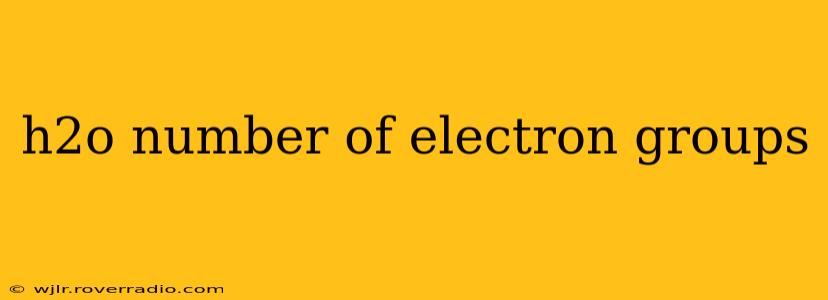Water (H₂O) is a simple yet fascinating molecule, crucial for life as we know it. Understanding its electron group arrangement is key to grasping its properties and behavior. This post will delve into the number of electron groups in H₂O and explore related concepts.
How Many Electron Groups Does H₂O Have?
Water has a total of four electron groups surrounding the central oxygen atom. Let's break this down:
- Two bonding pairs: These are the two pairs of electrons shared between the oxygen atom and each of the two hydrogen atoms, forming the two O-H bonds.
- Two lone pairs: These are two pairs of electrons that are not involved in bonding and reside solely on the oxygen atom. These lone pairs significantly influence the molecule's shape and properties.
It's crucial to distinguish between electron groups and bonding pairs. Electron groups encompass all electron pairs around the central atom—both bonding and lone pairs. This total number dictates the electron-domain geometry.
What is the Electron Domain Geometry of H₂O?
The four electron groups in H₂O lead to a tetrahedral electron-domain geometry. Imagine a tetrahedron—a four-sided pyramid—with the oxygen atom at the center and the four electron groups positioned at the corners. This is the arrangement that minimizes electron-electron repulsion, a fundamental principle in VSEPR (Valence Shell Electron Pair Repulsion) theory.
What is the Molecular Geometry of H₂O?
While the electron-domain geometry describes the arrangement of all electron groups, the molecular geometry only considers the positions of the atoms. The two lone pairs on the oxygen atom in H₂O significantly affect the molecular geometry. These lone pairs repel the bonding pairs, causing a distortion from the ideal tetrahedral shape.
Therefore, the molecular geometry of H₂O is bent or V-shaped. The two hydrogen atoms are not positioned at a 109.5° angle (as in a perfect tetrahedron) but at a smaller angle, approximately 104.5°. This bent shape is responsible for water's unique properties, including its high surface tension and polarity.
What is the hybridization of oxygen in H₂O?
The oxygen atom in H₂O undergoes sp³ hybridization. This means that one s orbital and three p orbitals of the oxygen atom hybridize to form four sp³ hybrid orbitals. Two of these sp³ hybrid orbitals form sigma bonds with the hydrogen atoms, while the other two contain the lone pairs of electrons. This hybridization model helps explain the tetrahedral electron-domain geometry and the bent molecular geometry of water.
How does the number of electron groups affect the properties of H₂O?
The presence of four electron groups, including two lone pairs, is directly responsible for several key properties of water:
- Polarity: The bent geometry and the presence of lone pairs create a significant dipole moment, making water a polar molecule. This polarity is responsible for its ability to dissolve many ionic compounds and its high boiling point.
- Hydrogen bonding: The lone pairs on the oxygen atom allow water molecules to form strong hydrogen bonds with each other. These hydrogen bonds contribute to water's high surface tension, high specific heat capacity, and high boiling point.
- Solvent properties: Water's polarity and ability to form hydrogen bonds make it an excellent solvent for many substances.
Understanding the electron groups in H₂O is fundamental to comprehending its unique properties and its critical role in various chemical and biological processes. This arrangement, dictated by the principles of VSEPR theory, explains why water behaves as it does, making it a truly remarkable molecule.
